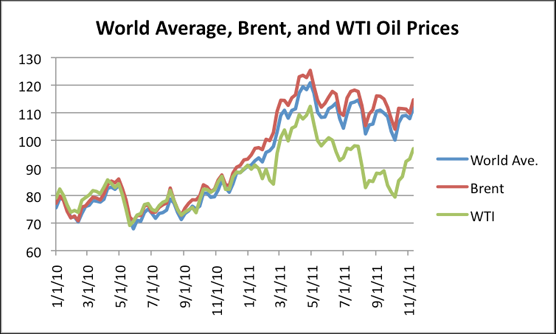WTI-Brent Spread Focus of Much Speculation
Many opinions and reasons have been given for the price difference observed between West Texas Intermediate (WTI) and Brent oil indices. To recap, the prices for these two assays have historically tracked close to one another. While they have periodically diverged, they have reverted to the historical trend relatively quickly. That is, until 2011. They diverged by more than 20% at one point (Brent being priced higher) and maintained a significant gap for 10 months running (about a $10 difference as of this writing in late November 2011). The graph below shows the recent anomaly and also indicates that it is WTI that is out of whack with the rest of the world rather than Brent being “too high.”

So why the larger-than-normal gap between WTI and Brent? Let’s go through some reasons given by various observers:

So why the larger-than-normal gap between WTI and Brent? Let’s go through some reasons given by various observers:
- Oversupply from Canada to the Midwest
- Constrained pipeline capacity, particularly in Cushing, Oklahoma where WTI is priced, limiting the market for WTI and driving down its price as compared to other assays which can be readily transported to a wide market
- Refinery margins – with a lower cost of acquisition (depressed WTI prices), it matters whether those lower costs are being passed through as lower gasoline and heating oil prices to consumers, thus maintaining a historical equilibrium between wholesale and retail prices
- Refinery capacity
- Global factors that impact the price of Brent, which is a globally traded commodity, but do not impact WTI, which is mostly beholden to local economic forces
You can return to the main Market News page, or press the Back button on your browser.

